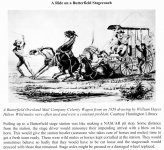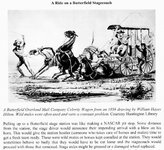Oroblanco
Gold Member
- Jan 21, 2005
- 7,838
- 9,830
- Detector(s) used
- Tesoro Lobo Supertraq, (95%) Garrett Scorpion (5%)
- Thread starter
- #21
Cactusjumper wrote
I realize that your reply was addressed to Beth, but as we are all on the same subject and you have raised two issues I am taking the liberty to respond - not to speak in Beth's place, as I am sure she can speak for herself.
At the risk of drifting ever farther off-topic here, I am a bit surprised at the rather sweeping statements of Dr Chandler. Firstly in that Wells Fargo was running stagecoaches in the period 1866 to 1869 under their own ownership, and apparently in Arizona so to say they never had stage operations in AZ is puzzling. Secondly as to not shipping ore by stage, is this a possible word definition problem? The are plenty of sources which could refute this, and I have yet another issue due to the fact that I also had talked to Dr Chandler; he had been 'primed' by a previous communication and responded to my question about any records for Arizona by saying that they had no records of Jacob Waltz shipping gold, which I had not (yet) asked. He also explained that they have NO records for the frontier period at all. So how can any statement be made, concerning what was, or what was NOT shipped? I would think that the stage might choose not to ship ore due to weight and space limitations aboard the average Concord coach, yet how would ore concentrates be classed? I have some documentary evidence of gold dust being shipped, which is not bullion, and strongly suspect that where we find actual records of Wells Fargo shipments of "bullion" it is referring to the bullion value of what was being carried and not refined precious metals specifically.
A quick peek online turns up a number of sources, the Engineering and Mining Journal 1879 is online and mentions Wells Fargo several times as shipping ores; the Congressional Edition for 1889 is online at http://books.google.com/books?id=DUBHAQAAIAAJ
<extract from page 141>
"Castle Dome district. The principal mines were practically idle during 1887. The amount of ore reported as shipped appears to have been about 12 tons carrying $840 silver and 60 per cent lead. Handsome specimens of fluorspar and of molybdate of lead are often found. Considerable placer mining was done the placers being worked with dry washers the gold being unusually coarse and pure most of which was shipped through Wells Fargo & Co's express at Yuma and the balance by private conveyance "
So I have to respectfully disagree with Dr Chandler's statements based on alternate sources, especially in light of the fact that Wells Fargo today has NO records on which to base such conclusions. It seems logical that ore concentrates as mentioned in the Congressional Record were in fact being shipped by Wells Fargo express, on stages at least until the freight could be transferred to trains or steamboats, as concentrates would be fairly compact both in weight and bulk and might be called either "bullion" based on the value contained and as "ore" being that it was still not fully refined.
As to how this relates to the Two Lost Adams, I am at a loss.
Roy


My source for "no Wells Fargo coaches in Arizona" was Dr. Robert J. Chandleer, Senior Research Historian for Wells Fargo Bank. That was one of the facts that he told me in a personal phone call a number of years ago.
Another piece of information from him, was that Wells Fargo did not ship ore by statecoach, only bullion and coin. Later on, when the railroad was completed into Arizona, they shipped ore east, I believe he said to Kansas City........ dontknow for sure.
Sure it's "nit-picking". Bad habit of mine. Hope you will forgive me.
I realize that your reply was addressed to Beth, but as we are all on the same subject and you have raised two issues I am taking the liberty to respond - not to speak in Beth's place, as I am sure she can speak for herself.
At the risk of drifting ever farther off-topic here, I am a bit surprised at the rather sweeping statements of Dr Chandler. Firstly in that Wells Fargo was running stagecoaches in the period 1866 to 1869 under their own ownership, and apparently in Arizona so to say they never had stage operations in AZ is puzzling. Secondly as to not shipping ore by stage, is this a possible word definition problem? The are plenty of sources which could refute this, and I have yet another issue due to the fact that I also had talked to Dr Chandler; he had been 'primed' by a previous communication and responded to my question about any records for Arizona by saying that they had no records of Jacob Waltz shipping gold, which I had not (yet) asked. He also explained that they have NO records for the frontier period at all. So how can any statement be made, concerning what was, or what was NOT shipped? I would think that the stage might choose not to ship ore due to weight and space limitations aboard the average Concord coach, yet how would ore concentrates be classed? I have some documentary evidence of gold dust being shipped, which is not bullion, and strongly suspect that where we find actual records of Wells Fargo shipments of "bullion" it is referring to the bullion value of what was being carried and not refined precious metals specifically.
A quick peek online turns up a number of sources, the Engineering and Mining Journal 1879 is online and mentions Wells Fargo several times as shipping ores; the Congressional Edition for 1889 is online at http://books.google.com/books?id=DUBHAQAAIAAJ
<extract from page 141>
"Castle Dome district. The principal mines were practically idle during 1887. The amount of ore reported as shipped appears to have been about 12 tons carrying $840 silver and 60 per cent lead. Handsome specimens of fluorspar and of molybdate of lead are often found. Considerable placer mining was done the placers being worked with dry washers the gold being unusually coarse and pure most of which was shipped through Wells Fargo & Co's express at Yuma and the balance by private conveyance "
So I have to respectfully disagree with Dr Chandler's statements based on alternate sources, especially in light of the fact that Wells Fargo today has NO records on which to base such conclusions. It seems logical that ore concentrates as mentioned in the Congressional Record were in fact being shipped by Wells Fargo express, on stages at least until the freight could be transferred to trains or steamboats, as concentrates would be fairly compact both in weight and bulk and might be called either "bullion" based on the value contained and as "ore" being that it was still not fully refined.
As to how this relates to the Two Lost Adams, I am at a loss.
Roy




 It is good for the brain, the soul and, often leads to new discoveries of information etc.
It is good for the brain, the soul and, often leads to new discoveries of information etc.



